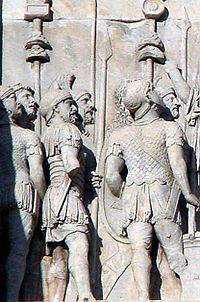
Signifer
Encyclopedia

Roman legion
A Roman legion normally indicates the basic ancient Roman army unit recruited specifically from Roman citizens. The organization of legions varied greatly over time but they were typically composed of perhaps 5,000 soldiers, divided into maniples and later into "cohorts"...
s. He carried a signum (standard) for a cohort
Cohort (military unit)
A cohort was the basic tactical unit of a Roman legion following the reforms of Gaius Marius in 107 BC.-Legionary cohort:...
or century
Centuria
Centuria is a Latin substantive from the stem centum , denoting units consisting of 100 men. It also denotes a Roman unit of land area: 1 centuria = 100 heredia...
. Each century had a signifer (thus, there were 59 in a legion) and within each cohort the first century's signifer would be the senior.
Signifer as the standard-bearer
The signum he carried was the military emblem of that unit. It comprised a number of philarae (disks or medallions) along with a number of other elements mounted on a pole. The pole could be topped with a leaf-shaped spear head or a manus (open human hand) image denoting the oath of loyalty taken by the soldiers. It sometimes included a representation of a wreath, probably denoting an honour or award.The task of carrying the signum in battle was dangerous as the soldier had to stand in the first rank and could carry only a small buckler
Buckler
A buckler is a small shield, 15 to 45 cm in diameter, gripped in the fist; it was generally used as a companion weapon in hand-to-hand combat during the Medieval and Renaissance, as its size made it poor protection against missile weapons but useful in deflecting the blow of...
. It was this banner that the men from each individual century would rally around. A soldier could also gain the position of discentes signiferorum, or standard bearer in training.
Signifer as the banker
In addition to carrying the signum, the signifer also assumed responsibility for the financial administration of the unit and functioned as the legionaries' banker. He was paid twice the basic wage.Signifer in the Roman Republic and the Roman Empire
In the Roman Republic the term signifer probably applied to all standard bearers, but in the Empire the signifer was just one of a number of types of signiferiSigniferi
The signiferi of the Roman legions were the ranks entrusted with various tasks to do with standard-bearing. Early in the Roman Republic the single rank signifer performed all these tasks but later in the Empire the tasks became more specialist with different ranks created for specific tasks,...
, which also included aquilifer
Aquilifer
An aquilifer was a senior signifer bearing the eagle standard of a Roman legion. The name derives from the type of standard, aquila meaning "eagle", which was the universal type used since 104 BC. Before that time, the wolf, boar, bull and horse were also used...
s, imaginifer
Imaginifer
The imaginifer was one of the signiferi in a legion in the times of the Roman Empire, who carried the imago - the image - of the emperor. The imaginifer was added to the ranks of the legions when the Imperial Cult was first established during the reign of Augustus. The imago was a three...
s, duplicarii
Duplicarius
A duplicary was a pay grade in the Roman Army receiving double the basic pay. The grade could also be awarded to ordinary legionary soldiers, regardless of rank, as a reward for outstanding bravery or service....
, vexillarii
Vexillarius
The Vexillarius can mean one of three things:First, a Vexillarius or Vexillifer was one of the signiferi in a Roman legion. His duty was to carry the Vexillum, a military standard displaying the name and emblem of the legion. This standard consisted of a woven fabric banner, hung on a crossbar...
and draconarii
Draconarius
For the spider genus in the family Amaurobiidae, see : Draconarius .The draconarius was a type of signiferi who bore a cavalry standard known as a draco in the Roman army.- Name :...
.
See also
- AquiliferAquiliferAn aquilifer was a senior signifer bearing the eagle standard of a Roman legion. The name derives from the type of standard, aquila meaning "eagle", which was the universal type used since 104 BC. Before that time, the wolf, boar, bull and horse were also used...
- ImaginiferImaginiferThe imaginifer was one of the signiferi in a legion in the times of the Roman Empire, who carried the imago - the image - of the emperor. The imaginifer was added to the ranks of the legions when the Imperial Cult was first established during the reign of Augustus. The imago was a three...
- VexillariusVexillariusThe Vexillarius can mean one of three things:First, a Vexillarius or Vexillifer was one of the signiferi in a Roman legion. His duty was to carry the Vexillum, a military standard displaying the name and emblem of the legion. This standard consisted of a woven fabric banner, hung on a crossbar...
- DraconariusDraconariusFor the spider genus in the family Amaurobiidae, see : Draconarius .The draconarius was a type of signiferi who bore a cavalry standard known as a draco in the Roman army.- Name :...
- Colours, standards and guidonsColours, standards and guidonsIn military organizations, the practice of carrying colours, standards or Guidons, both to act as a rallying point for troops and to mark the location of the commander, is thought to have originated in Ancient Egypt some 5,000 years ago...

